
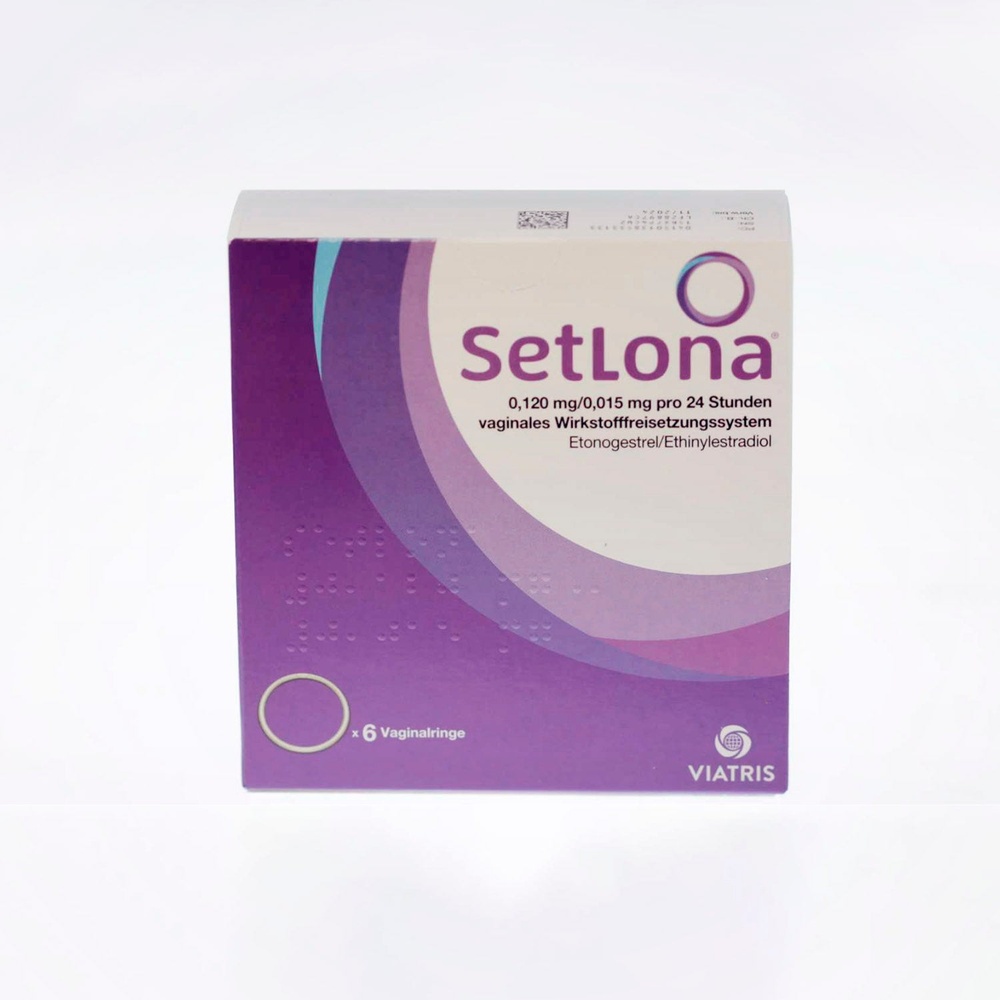
SETLONA 0.120 MG/0.015 MG every 24 hours vaginal delivery system


How to use SETLONA 0.120 MG/0.015 MG every 24 hours vaginal delivery system
Introduction
Package Leaflet: Information for the Patient
Setlona 0.120 mg/0.015 mg every 24 hours, vaginal EFG release system
etonogestrel/ethinylestradiol
Important things you should know about combined hormonal contraceptives (CHCs):
- They are one of the most reliable reversible contraceptive methods if used correctly.
- They slightly increase the risk of having a blood clot in the veins and arteries, especially in the first year or when restarting the use of a combined hormonal contraceptive after a pause of 4 weeks or more.
- Be alert and consult your doctor if you think you may have symptoms of a blood clot (see section 2 "Blood Clots").
Read the entire package leaflet carefully before starting to use this medication, as it contains important information for you.
- Keep this package leaflet, as you may need to read it again.
- If you have any questions, consult your doctor or pharmacist.
- This medication has been prescribed to you only, and you should not give it to others, even if they have the same symptoms as you, as it may harm them.
- If you experience side effects, consult your doctor or pharmacist, even if they are side effects not listed in this package leaflet. See section 4.
Your medication is referred to by the full name above, but throughout this package leaflet, it will be referred to as Setlona.
Contents of the Package Leaflet
- What is Setlona and what is it used for
- What you need to know before starting to use Setlona
2.1 When not to use Setlona
2.2 Warnings and precautions
Blood Clots
Cancer
2.3 Children and adolescents
2.4 Other medications and Setlona
Laboratory tests
2.5 Pregnancy and breastfeeding
2.6 Driving and using machines
- How to use Setlona
3.1 How to put on and remove Setlona
3.2 Three weeks in, one week out
3.3 When to start with the first ring
3.4 What to do if...
Your ring is accidentally expelled from the vagina
Your ring has been temporarily out of the vagina
The ring breaks
You have put on more than one ring
If you forget to put on a new ring after the ring-free interval
If you have forgotten to remove the ring
If your period or menstrual bleeding does not occur
If you have unexpected bleeding
If you want to change the day your period or menstrual bleeding starts
If you want to delay your period or menstrual bleeding
3.5 If you want to stop using Setlona
- Possible side effects
- Storage of Setlona
- Package contents and additional information
Composition of Setlona
Appearance of Setlona and package contents
Marketing authorization holder and manufacturer
1. What is Setlona and what is it used for
Setlona is a vaginal contraceptive ring used to prevent pregnancy. Each ring contains a small amount of two female sex hormones, etonogestrel and ethinylestradiol. The ring slowly releases these hormones into the bloodstream. Given the small amount of hormones released, Setlona is a low-dose hormonal contraceptive. As Setlona releases two different types of hormones, it is a combined hormonal contraceptive.
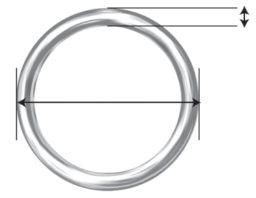
Setlona works like the combined oral contraceptive pill (the "Pill"), but instead of taking a pill every day, the ring is used for 3 consecutive weeks. Setlona releases two female sex hormones that prevent the ovaries from releasing an egg. If no egg is released, you cannot become pregnant.
2. What you need to know before using Setlona
General considerations
Before starting to use Setlona, you should read the information about blood clots in section 2. It is particularly important that you read the symptoms of a blood clot (see section 2 "Blood clots").
In this prospectus, various situations are described in which you should stop using Setlona, or in which Setlona may be less reliable. In these situations, you should not have sexual intercourse, or you should take additional non-hormonal contraceptive measures, such as a male condom or another barrier method. Do notuse the rhythm or temperature method. These methods may not be reliable since Setlona alters the monthly changes in body temperature and cervical mucus.
Setlona, like other hormonal contraceptives, does not protect against HIV infection (AIDS) or any other sexually transmitted disease.
2.1 When you should not use Setlona
You should not use Setlona if you have any of the conditions listed below. Inform your doctor if you have any of the conditions listed below. Your doctor will discuss with you what other form of contraception would be more suitable.
- If you have (or have ever had) a blood clot in a blood vessel of the legs (deep vein thrombosis, DVT), in the lungs (pulmonary embolism, PE) or in other organs.
- If you know you have a disorder that affects blood clotting: for example, protein C deficiency, protein S deficiency, antithrombin III deficiency, factor V Leiden or antiphospholipid antibodies.
- If you need an operation or if you spend a lot of time without getting up (see section "Blood clots").
- If you have ever had a heart attack or stroke.
- If you have (or have ever had) angina pectoris (a condition that causes severe chest pain and may be the first sign of a heart attack) or a transient ischemic attack (TIA, temporary stroke symptoms).
- If you have any of the following diseases that may increase your risk of forming a clot in the arteries:
- severe diabetes with blood vessel damage
- very high blood pressure
- very high levels of fat in the blood (cholesterol or triglycerides)
-a condition called hyperhomocysteinemia.
- If you have (or have ever had) a type of migraine called "migraine with aura".
- If you have (or have ever had) inflammation of the pancreas (pancreatitis), associated with high levels of fat in your blood.
- If you have (or have ever had) a severe liver disease and your liver is not yet working normally.
- If you have (or have ever had) a benign or malignant tumor in the liver.
- If you have (or have ever had), or could have, breast cancer or cancer of the genital organs.
- If you have any vaginal bleeding of unknown origin.
- If you are allergic to ethinylestradiol or etonogestrel, or to any of the other components of this medicine (listed in section 6).
If any of these circumstances occur for the first time while using Setlona, remove the ring immediately and consult your doctor. In the meantime, use non-hormonal contraceptive measures.
Do not use Setlona if you have hepatitis C and are taking medicines that contain ombitasvir/paritaprevir/ritonavir, dasabuvir, glecaprevir/pibrentasvir or sofosbuvir/velpatasvir/voxilaprevir (see also section 2.4 "Other medicines and Setlona").
2.2 Warnings and precautions
When should you consult your doctor?
Seek urgent medical attention
- If you notice possible signs of a blood clot that may mean you are suffering from a blood clot in the leg (i.e., deep vein thrombosis), a blood clot in the lung (i.e., pulmonary embolism), a heart attack, or a stroke (see section "Blood clots" below).
To obtain a description of the symptoms of these serious side effects, see "How to recognize a blood clot".
Tell your doctor if you suffer from any of the following conditions.
Consult your doctor or pharmacist before using Setlona.
If the condition develops or worsens while you are using Setlona, you should also inform your doctor.
- If a close relative has or has had breast cancer.
- If you suffer from epilepsy (see section 2.4 "Other medicines and Setlona").
- If you have a liver disease (e.g., jaundice) or gallbladder disease (e.g., gallstones).
- If you have Crohn's disease or ulcerative colitis (chronic inflammatory bowel disease);
- If you have systemic lupus erythematosus (SLE, a disease that affects your natural defense system).
- If you have hemolytic uremic syndrome (HUS, a blood clotting disorder that causes kidney failure).
- If you have sickle cell anemia (a hereditary disease of red blood cells).
- If you have high levels of fat in the blood (hypertriglyceridemia) or a known family history of this condition. Hypertriglyceridemia has been associated with an increased risk of pancreatitis (inflammation of the pancreas).
- If you need an operation or spend a lot of time without getting up (see section 2 "Blood clots").
- If you have just given birth, you are at a higher risk of blood clots. You should ask your doctor when you can start taking Setlona after childbirth.
- If you have inflammation of the veins that are under the skin (superficial thrombophlebitis);
- If you have varicose veins.
- If you suffer from any disease that first appeared or worsened during pregnancy or previous use of sex hormones (e.g., hearing loss, porphyria [a blood disease], pregnancy herpes [a skin rash with blisters during pregnancy], or Sydenham's chorea [a nervous system disease in which involuntary movements occur];
- If you experience symptoms of angioedema, such as swelling of the face, tongue, or throat, or difficulty swallowing, or urticaria with possible difficulty breathing, see your doctor immediately. Medicines that contain estrogen can cause or worsen symptoms of hereditary or acquired angioedema.
- If you have or have ever had chloasma (yellowish-brown spots on the skin, called "pregnancy spots", especially on the face); if this is the case, avoid excessive exposure to the sun or ultraviolet rays.
- If you have disorders that make it difficult to use Setlona, for example, if you suffer from constipation, if you have a cervical prolapse or feel pain during sexual intercourse.
- If you have urgent, frequent, burning, and/or painful urination, and you cannot locate the ring in the vagina. These symptoms may indicate accidental placement of Setlona in the urinary bladder.
BLOOD CLOTS
The use of a combined hormonal contraceptive like Setlona increases your risk of having a blood clot compared to not using it. In rare cases, a blood clot can block blood vessels and cause serious problems.
Blood clots can form:
- In the veins (this is called "venous thrombosis", "venous thromboembolism" or VTE).
- In the arteries (this is called "arterial thrombosis", "arterial thromboembolism" or ATE).
Recovery from blood clots is not always complete. In rare cases, there can be serious long-term effects or, very rarely, they can be fatal.
It is essential to remember that the overall risk of a harmful blood clot due to Setlona is small.
HOW TO RECOGNIZE A BLOOD CLOT
Seek urgent medical attention if you notice any of the following signs or symptoms.
Are you experiencing any of these signs? | What might you be suffering from? |
| Deep vein thrombosis |
If you are unsure, consult a doctor, as some of these symptoms, such as cough or shortness of breath, can be confused with a milder condition such as a respiratory infection (e.g., a "common cold"). | Pulmonary embolism |
Symptoms that occur more frequently in one eye:
| Retinal vein thrombosis (blood clot in the eye). |
| Heart attack |
especially on one side of the body;
A sudden severe headache without a known cause;
Sometimes the symptoms of a stroke can be brief, with almost immediate and complete recovery, but you should seek urgent medical attention as you may be at risk of having another stroke. | Stroke |
| Blood clots that block other blood vessels. |
BLOOD CLOTS IN A VEIN
What can happen if a blood clot forms in a vein?
- The use of combined hormonal contraceptives has been associated with an increased risk of blood clots in the veins (venous thrombosis). However, these side effects are rare. They occur more frequently in the first year of use of a combined hormonal contraceptive.
- If a blood clot forms in a vein in the leg or foot, it can cause deep vein thrombosis (DVT).
- If a blood clot moves from the leg and lodges in the lung, it can cause a pulmonary embolism.
- In very rare cases, a clot can form in a vein of another organ, such as the eye (retinal vein thrombosis).
When is the risk of a blood clot in a vein higher?
The risk of having a blood clot in a vein is higher during the first year in which you take a combined hormonal contraceptive for the first time. The risk may also be higher if you start taking a combined hormonal contraceptive (the same medicine or a different one) after an interruption of 4 weeks or more.
After the first year, the risk decreases, but it is always slightly higher than if you were not taking a combined hormonal contraceptive.
When you stop using Setlona, your risk of having a blood clot returns to normal within a few weeks.
What is the risk of having a blood clot?
The risk depends on your natural risk of VTE and the type of combined hormonal contraceptive you are taking.
The overall risk of having a blood clot in the leg or lung (DVT or PE) with Setlona is small.
- Out of 10,000 women who do not use a combined hormonal contraceptive and are not pregnant, about 2 will have a blood clot in a year.
- Out of 10,000 women who use a combined hormonal contraceptive that contains levonorgestrel, norethisterone, or norgestimate, about 5-7 will have a blood clot in a year.
- Out of 10,000 women who use a combined hormonal contraceptive that contains norelgestromin or etonogestrel, like Setlona, between 6 and 12 women will have a blood clot in a year.
- The risk of having a blood clot will depend on your personal history (see "Factors that increase your risk of a blood clot" below).
Risk of having a blood clot in a year | |
Women who do not usea combined hormonal contraceptive pill/patch/ring and who are not pregnant | About 2 out of 10,000 women |
Women who use a combined hormonal contraceptive pill that contains levonorgestrel, norethisterone, or norgestimate | About 5-7 out of 10,000 women |
Women who use Setlona | About 6-12 out of 10,000 women |
Factors that increase your risk of a blood clot in a vein
The risk of having a blood clot with Setlona is small, but some conditions increase the risk. Your risk is higher:
- If you are overweight (body mass index or BMI over 30 kg/m2).
- If any of your close relatives have had a blood clot in the leg, lung, or other organ at a young age (e.g., before the age of 50). In this case, you may have a hereditary blood clotting disorder.
- If you need an operation or spend a lot of time without getting up due to an injury or illness or if you have a leg in a cast. You may need to stop using Setlona several weeks before surgery or while you have reduced mobility. If you need to stop using Setlona, ask your doctor when you can start using it again.
- As you get older (especially above 35 years).
- If you have given birth in the last few weeks.
The risk of having a blood clot increases with the number of conditions you have.
Long-distance flights (more than 4 hours) may temporarily increase the risk of a blood clot, especially if you have any of the other risk factors listed.
It is essential to inform your doctor if you suffer from any of the above conditions, even if you are not sure. Your doctor may decide that you should stop using Setlona.
If any of the above conditions change while you are using Setlona, for example, a close relative experiences a thrombosis without a known cause or you gain a lot of weight, inform your doctor.
BLOOD CLOTS IN AN ARTERY
What can happen if a blood clot forms in an artery?
Like a blood clot in a vein, a clot in an artery can cause serious problems. For example, it can cause a heart attack or stroke.
Factors that increase your risk of a blood clot in an artery
It is essential to note that the risk of a heart attack or stroke due to Setlona is very small, but it can increase:
- With age (above 35 years).
- If you smoke. When using a combined hormonal contraceptive like Setlona, you are advised to quit smoking. If you are unable to quit smoking and are over 35 years old, your doctor may advise you to use a different type of contraceptive.
- If you are overweight.
- If you have high blood pressure.
- If any of your close relatives have had a heart attack or stroke at a young age (less than 50 years). In this case, you may also be at higher risk of having a heart attack or stroke.
- If you or any of your close relatives have high levels of fat in the blood (cholesterol or triglycerides).
- If you suffer from migraines, especially migraines with aura.
- If you have a heart problem (valve disorder, heart rhythm disorder called atrial fibrillation).
- If you have diabetes.
If you have more than one of these conditions or if any of them are particularly severe, the risk of having a blood clot may be increased further.
If any of the above conditions change while you are using Setlona, for example, you start smoking, a close relative experiences a thrombosis without a known cause, or you gain a lot of weight, inform your doctor.
Cancer
The following information has been obtained from studies with combined oral contraceptives and may be applicable to Setlona. No information is available on the administration of contraceptive hormones via the vagina (such as Setlona).
Cases of breast cancer have been observed with a slightly higher frequency in women who use oral contraceptives, but it is not known if this is due to the treatment. For example, it may be that more tumors are found in women who use oral contraceptives because they have more frequent medical check-ups. This increased frequency decreases gradually after stopping treatment.
It is essential to examine your breasts regularly and inform your doctor if you notice any lump. Inform your doctor if any close relative has or has had breast cancer (see section 2.2 "Warnings and precautions").
Rare cases of benign and malignant liver tumors have been reported in women who use oral contraceptives. Contact your doctor if you have severe and unusual abdominal pain.
In users of the combined pill, it has been observed that endometrial cancer (the tissue that lines the uterus) and ovarian cancer occur less frequently. This may also be the case with Setlona, but it has not been confirmed.
Psychiatric disorders:
Some women who use hormonal contraceptives like {product name} have reported depression or a depressed mood. Depression can be severe and sometimes can induce suicidal thoughts. If you experience mood changes and depressive symptoms, consult your doctor immediately.
Contact your doctor for additional medical advice as soon as possible.
2.3 Children and Adolescents
The safety and efficacy of Setlona in adolescents under 18 years of age have not been established.
2.4 Other Medications and Setlona
Always inform your doctor about the medications or herbal remedies you are taking. Also, inform any doctor or dentist (or pharmacist) that you are using Setlona. They will be able to tell you if you need to take any additional contraceptive measures (e.g., male condom) and, if necessary, for how long, or if you should modify the use of the other medication.
Some medications
- may have an influence on Setlona levels in the blood.
- may make it less effective in preventing pregnancy.
- may cause unexpected bleeding.
These include medications used to treat:
- Epilepsy (e.g., primidone, phenytoin, barbiturics, carbamazepine, oxcarbazepine, topiramate, felbamate).
- Tuberculosis (e.g., rifampicin).
- HIV infection (e.g., ritonavir, nelfinavir, nevirapine, efavirenz).
- Hepatitis C virus infection (e.g., boceprevir, telaprevir).
- Other infectious diseases (e.g., griseofulvin).
- High blood pressure in the pulmonary blood vessels (bosentan).
- Depressive mood disorders (the herbal remedy St. John's Wort (Hypericum perforatum)).
If you are taking medications or herbal remedies that could make Setlona less effective, you should also use a barrier contraceptive method. Since the effect of another medication on Setlona can last up to 28 days after stopping the medication, during that time, it is necessary to use an additional barrier contraceptive method.
Note: Do not use Setlona with a diaphragm, cervical cap, or female condom.
Setlona may affect the effect of other medications, for example:
- medications containing cyclosporine.
- the antiepileptic lamotrigine (this could lead to an increased frequency of seizures).
Do not use Setlona if you have Hepatitis C and are taking medications containing ombitasvir/paritaprevir/ritonavir, dasabuvir, glecaprevir/pibrentasvir, or sofosbuvir/velpatasvir/voxilaprevir, as these medications may produce increases in liver test results (increase in liver enzyme ALT).
Your doctor will prescribe another type of contraceptive before starting treatment with these medications.
Setlona can be used again approximately 2 weeks after the end of this treatment. See section 2.1 "When not to use Setlona".
Consult your doctor or pharmacist before taking any medication.
Tampons can be used while using Setlona. First, insert Setlona and then the tampon. Be careful when removing the tampon so that the ring is not accidentally expelled. If it is expelled, simply wash the ring with cold or warm water and reinsert it immediately.
The use of spermicides or products for vaginal fungi does not reduce the contraceptive efficacy of Setlona.
Laboratory Tests
If you have blood or urine tests, inform your doctor that you use Setlona, as it may affect the result of some tests.
2.5 Pregnancy and Breastfeeding
Pregnant women or those who suspect they may be pregnant should not use Setlona. If you become pregnant while using Setlona, you should remove the ring and consult your doctor.
If you want to stop using Setlona because you want to become pregnant, see section 3.5 "If you want to stop using Setlona".
In general, it is not recommended to use Setlona during breastfeeding. If you want to use Setlona while breastfeeding, consult your doctor.
2.6 Driving and Using Machines
It is unlikely that Setlona will affect your ability to drive or use machines.
3. How to use Setlona
You can put in and remove Setlona yourself. Your doctor will tell you when to start using it for the first time. The vaginal ring should be inserted on the correct day of your menstrual cycle (see section 3.3 "When to start with the first ring") and remain in the vagina for 3 consecutive weeks. Regularly check if Setlona is still in your vagina (for example, before and after having sex) to ensure you are protected against pregnancy. After the third week, remove Setlona and take a 1-week break. You will normally have your period or menstrual bleeding during this ring-free break.
While using Setlona, you should not use certain female barrier contraceptive methods, such as the vaginal diaphragm, cervical cap, or female condom. These barrier contraceptive methods should not be used as a backup method of birth control, as Setlona may interfere with the correct placement and positioning of the diaphragm, cervical cap, or female condom. However, you can use a male condom as an additional barrier contraceptive method.
3.1 How to put in and remove Setlona
- Before putting in the ring, check that it is not expired (see section 5 "Storage of Setlona").
- Wash your hands before putting in or removing the ring.
- Choose a position that is most comfortable for you to insert it, for example, standing with one leg raised, squatting, or lying down.
- Remove Setlona from its pouch. Save the pouch for later use.
- Hold the ring between your index and thumb fingers, press the opposite sides, and insert the ring into the vagina (see figures 1-4).
When Setlona is in place, you should not feel anything. If you feel uncomfortable, gently push Setlona further into the vagina. The exact position of the ring inside the vagina is not important.
- After 3 weeks, remove Setlona from the vagina. You can do this by hooking the ring with your index finger or holding it with your fingers and pulling it out (see figure 5). If you are unable to remove the ring despite having located it, contact your doctor.
- Dispose of the used ring with your normal household trash, preferably in its pouch. Do not flush Setlona down the toilet.

Figure 1
Remove Setlona from its pouch.

Figure 2
Press the ring.
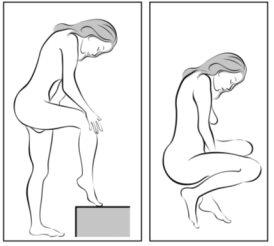
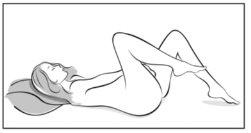
Figure 3
Choose a comfortable position to put in the ring.
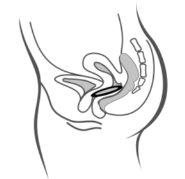
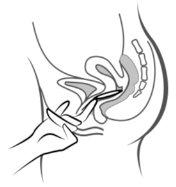
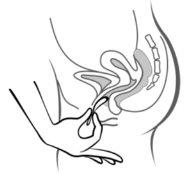
Figure 4A Figure 4B Figure 4C
Put the ring into the vagina with one hand (Figure 4A); if necessary, separate the vaginal lips with the other hand. Push the ring into the vagina until you feel comfortable (Figure 4B). Leave the ring in the vagina for 3 weeks (Figure 4C).
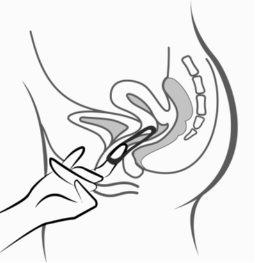
Figure 5:
Setlona can be removed by hooking the ring with your index finger or holding it between your index and middle fingers and pulling it out.
3.2 Three weeks in, one week out
- The vaginal ring should remain in the vagina from the day it is put in for 3 consecutive weeks, uninterrupted.
- After 3 weeks, remove the ring on the same day of the week that you put it in and at approximately the same time. For example, if you put in Setlona on a Wednesday at approximately 10:00 PM, you should remove it 3 weeks later, on a Wednesday, at approximately 10:00 PM.
- Once you have removed the ring, do not use it during the 1-week break. During this week, you should experience vaginal bleeding. It usually starts 2-3 days after removing Setlona.
- Put in a new ring exactly after the 1-week break (again on the same day of the week and at approximately the same time), even if you are still bleeding.
If you put in a new ring more than 3 hours late, the contraceptive effectiveness may be reduced. Follow the instructions in section 3.4 "What to do if you forget to put in a new ring after the ring-free break".
If you use Setlona as described above, your vaginal bleeding will take place approximately on the same days each month.
3.3 When to start with the first ring
- If you have not used hormonal contraception in the previous month
Put in Setlona on the first day of your natural cycle (i.e., the first day of your menstruation). Setlona starts working immediately. You do not need to take any other contraceptive measures.
You can also start with Setlona between the 2nd and 5th day of your cycle, but if you have sex during the first 7 days of using Setlona, make sure to use a complementary contraceptive method (male condom). You should only follow this recommendation when using Setlona for the first time.
- If you were using a combined pill in the previous month
Start using Setlona no later than the day after the break from your current pill. If the package of your pill also contains placebo pills, start Setlona no later than the day after the last placebo pill. If you are unsure which pill is which, consult your doctor or pharmacist. Never extend the pill-free days of your current pill beyond what is recommended. If you have taken your current pill continuously and correctly and are sure you are not pregnant, you can also stop taking the pill on any day of your current cycle and start with Setlona immediately.
- If you were using a transdermal patch in the previous month
Start using Setlona no later than the day after the patch-free break. Do not extend the patch-free days beyond what is recommended. If you have used the patch continuously and correctly, and are sure you are not pregnant, you can also remove the patch on any day and start with Setlona immediately.
- If you were using a progestin-only pill in the previous month
You can stop taking your progestin-only pill on any day and start Setlona the next day at the same time you would have taken your pill. However, make sure to also use a complementary contraceptive method (such as a male condom) during the first 7 days of using the ring.
- If you were using an injectable, implant, or Hormonal Intrauterine System (IUS) in the previous month.
Start using Setlona when you would have received the next injection or on the day the implant or IUS is removed. However, make sure to use a complementary contraceptive method (such as a male condom) during the first 7 days of using the ring.
- After childbirth
If you have just given birth, your doctor may advise you to wait until your first normal period appears before starting with Setlona. Sometimes it is possible to start earlier; your doctor will advise you on how to do so. If you are breastfeeding and want to use Setlona, you should consult your doctor first.
- After an abortion
Consult your doctor.
3.4 What to do if...
The ring is accidentally expelled from the vagina
Setlona can be accidentally expelled from the vagina, for example, if it is not inserted correctly, when removing a tampon, during sex, if you have constipation, or if you have uterine prolapse. Therefore, you should regularly check if the ring is in your vagina (for example, before and after having sex).
If the ring has been expelled and it has been less than 3 hours, it will still protect you from pregnancy. You can wash the ring with cold or lukewarm water (do not use hot water) and put it back in. If the ring has been expelled and more than 3 hours have passed, it may not protect you from pregnancy; see the recommendation in section 3.4 "What to do if... the ring has been out of the vagina temporarily".
The ring has been out of the vagina temporarily
In the vagina, Setlona slowly releases hormones into the body to prevent pregnancy. If the ring has been out of the vagina for more than 3 hours, it may not protect you from pregnancy. Therefore, the ring cannot be out of the vagina for more than 3 hours in a 24-hour period.
- If the ring has been out of the vagina and less than 3 hours have passed, it will still protect you from pregnancy. You should put the ring back in as soon as possible, always within 3 hours.
- If the ring is out of the vagina or you suspect it has been out of the vagina for more than 3 hours in the 1st or 2nd week, it may not protect you from pregnancy. Put the ring back in as soon as you remember and leave it in the vagina for at least 7 consecutive days. Use a male condom if you have sex during those 7 days. If you are in the first week and have had sex in the previous 7 days, there is a possibility that you may be pregnant. In this case, consult your doctor.
- If the ring has been out of the vagina or you suspect it has been out of the vagina for more than 3 hours in the 3rd week, it may not protect you from pregnancy. You should remove the ring and choose one of the following two options:
1 - Put in a new ring immediately.
By putting in a new ring, you will start a new 3-week cycle of use, and you may not experience your period. However, you may experience intermenstrual bleeding or spotting during that cycle.
2 - Do not put in a new ring. Wait for your menstrual period and put in a new ring no later than 7 days from the time the previous ring was removed or expelled.
Choose this option only if you have used Setlona continuously for the previous 7 days.
- If Setlona has been out of the vagina for an unknown amount of time, you may not be protected from pregnancy. Take a pregnancy test and consult your doctor before putting in a new ring.
The ring breaks
It is rare for the Setlona ring to break. Vaginal injury related to ring breakage has been reported. If you notice that Setlona has broken, remove the ring and put in a new one as soon as possible. Take complementary contraceptive precautions (for example, a male condom) for the following 7 days. If you have had sex before noticing that the ring had broken, consult your doctor.
You have put in more than one ring
There are no reports of serious harm due to overdose of Setlona's hormones. If you have accidentally put in more than one ring, you may feel unwell (nausea), vomit, or experience vaginal bleeding. Remove the extra ring and contact your doctor if these symptoms do not disappear.
You can also call the Toxicology Information Service. Phone: 915 620 420, indicating the medication and the amount used.
If you forget to put in a new ring after the ring-free break
If your ring-free breakhas lasted more than 7 days, put in a new ring in the vagina as soon as you remember. Take additional contraceptive measures (such as a male condom) if you have sex during the following 7 days. If you have had sex during this ring-free break, there is a possibility that you may be pregnant. In this case, inform your doctor immediately. The longer the ring-free break, the higher the risk of becoming pregnant.
If you forget to remove the ring
- If the ring has been in the vagina for 3 to 4 weeks, it will still protect you from pregnancy. Wait for the ring-free week and then put in a new ring.
- If the ring has been in the vagina for more than 4 weeks, there is a possibility of pregnancy. Contact your doctor before starting with a new ring.
If your period or menstrual bleeding does not occur
- You have used Setlona according to the instructions
If your period does not occur, but you have used Setlona according to the instructions and have not taken any other medications, it is very unlikely that you are pregnant. Continue using Setlona as usual. However, if you have two consecutive missed periods, you may be pregnant, so you should inform your doctor immediately. Do not put in the next Setlona until your doctor has checked that you are not pregnant.
- If you have deviated from the recommended use of Setlona
If your usual bleeding does not occur during the 1-week break without a ring and you have deviated from the recommended regimen, there is a possibility that you may be pregnant, so you should contact your doctor before putting in a new Setlona.
If you experience unexpected bleeding
In some women, during the use of Setlona, unexpected vaginal bleeding may occur between menstrual periods. You may need to use hygienic protection. However, continue to use the ring as usual; do not remove it. If the bleeding continues, becomes heavier, or starts again, consult your doctor.
If you want to change the day your period or menstrual bleeding starts
If you use Setlona according to the instructions, your menstrual period (withdrawal bleeding) will start during the ring-free week. If you want to change the day it starts, you must shorten (never lengthen!) the ring-free break.
For example, if your period usually starts on a Friday, you can change it to a Tuesday, i.e., 3 days earlier, starting from the next month. Simply put in the next ring 3 days earlier than your usual day.
If the break is very short (for example, 3 days or less), you may not experience your usual bleeding. You may experience spotting (drops or spots of blood) or intermenstrual bleeding during the use of the next ring.
If you are unsure how to do this, consult your doctor
If you want to delay your period or menstrual bleeding
Although it is not the recommended regimen, you can delay your menstrual period (withdrawal bleeding) by putting in a new ring immediately after removing the current ring, without taking the break between rings. You can leave the new ring in for up to 3 weeks. During the use of the new ring, you may experience spotting (drops or spots of blood) or irregular bleeding. When you want your period to start, simply remove the ring. Take the normal 1-week break without a ring and then put in a new ring.
You can consult your doctor before deciding to delay your menstrual period.
3.5 If you want to stop using Setlona
You can stop using Setlona at any time you want.
If you do not want to become pregnant, consult your doctor about other contraceptive methods.
If you stop using Setlona because you want to become pregnant, it is recommended to wait until you have had your first natural period before trying to conceive. This will help you calculate the expected date of delivery.
4. Possible Adverse Effects
Like all medicines, this medicine can cause adverse effects, although not all people suffer from them. If you experience any adverse effect, especially if it is severe or persistent, or if you have any change in health that you think may be due to Setlona, consult your doctor.
All women who take combined hormonal contraceptives are at a higher risk of developing blood clots in the veins (venous thromboembolism (VTE)) or blood clots in the arteries (arterial thromboembolism (ATE)). For more detailed information on the different risks of taking combined hormonal contraceptives, see section 2 "What you need to know before using Setlona".
If you notice any of the following adverse effects, you may need urgent medical attention. Stop using Setlona and contact your doctor immediately.
Contact your doctor immediately if you experience any of the following symptoms of angioedema: swelling of the face, tongue, and/or throat and/or difficulty swallowing or urticaria with possible difficulty breathing (see also section "Warnings and Precautions")
Users of the ring containing etonogestrel/ethinylestradiol have reported the following adverse effects:
Frequent: may affect up to 1 in 10 women
- abdominal pain, discomfort (nausea)
- vaginal yeast infection (similar to oral candidiasis), vaginal discomfort due to the ring, genital itching, vaginal discharge
- headache or migraine, depressive mood, decreased sexual desire
- breast pain, pelvic pain, painful menstruation
- acne
- weight gain
- expulsion of the ring
Uncommon: may affect up to 1 in 100 women
- vision changes, dizziness
- bloating, vomiting, diarrhea, or constipation
- feeling tired, irritable, or moody, mood changes, changes in mood
- fluid retention in the body (edema)
- urinary tract infection or bladder infection
- difficulty or pain when urinating; urgency to urinate; need to urinate more frequently
- problems with sexual intercourse such as pain, bleeding, or the partner noticing the ring
- increased blood pressure
- increased appetite
- back pain, muscle cramps, pain in the legs or arms
- decreased skin sensitivity
- breast tension or pain, or increased size; fibrocystic breast disease (breast cysts that can become swollen or painful)
- cervical inflammation, polyps that grow on the cervix, displacement of tissue from the inside of the cervix to the outside (ectropion)
- changes in menstrual period (e.g., heavier, longer, irregular, or disappearance of period), pelvic pain, premenstrual syndrome, uterine cramps
- vaginal infection (by fungi or bacteria), burning, odor, pain, discomfort, or dryness of the vagina or vulva
- hair loss, eczema, itching, rash, or flushing
- urticaria
Rare: may affect up to 1 in 1,000 women
- harmful blood clots in a vein or artery, for example:
- in a leg or foot (i.e., DVT)
- in a lung (i.e., PE)
- heart attack
- stroke
- mild stroke or temporary symptoms similar to those of a stroke, called a transient ischemic attack (TIA)
- blood clots in the liver, stomach/intestine, kidneys, or eyes
The likelihood of having a blood clot may be higher if you have any other condition that increases this risk (see section 2 for more information on conditions that increase the risk of blood clots and symptoms of a blood clot).
- breast secretion
Frequency not known (cannot be estimated from available data)
- chloasma (yellowish-brown spots on the skin, particularly on the face)
- penile discomfort (irritation, rash, itching)
- inability to remove the ring without medical assistance (e.g., due to its adherence to the vaginal wall)
- vaginal injury related to ring breakage
There have been reports of breast cancer and liver tumors in women using combined hormonal contraceptives. For more information, see section 2.2 "Warnings and Precautions, Cancer".
On very rare occasions, the ring may break. For more information, see section 3.4 "What to do if...The ring breaks".
Reporting Adverse Effects
If you experience any type of adverse effect, consult your doctor or pharmacist, even if it is a possible adverse effect that is not listed in this prospectus. You can also report it directly through the Spanish Pharmacovigilance System for Human Use Medicines: https://www.notificaram.es. By reporting adverse effects, you can contribute to providing more information on the safety of this medicine.
5. Storage of Setlona
Keep this medicine out of sight and reach of children.
If you discover that a child has been exposed to the hormones of Setlona, seek advice from your doctor.
This medicine does not require any special storage temperature.
Store in the original packaging to protect it from light.
This medicine must be used at least one month before the expiration date that appears
on the box and on each sachet after CAD or EXP. The expiration date refers to the last day of the month indicated.
Do not use Setlona if you notice changes in the color of the ring or any visible sign of deterioration.
This medicine may pose a risk to the environment. After removal, Setlona should be placed in the sachet and closed properly.The disposal of the sachet should be done with household waste or returned to the pharmacy for proper destruction in accordance with local regulations.
This medicine should not be thrown down the toilet. Like other medicines, do not throw unused or expired rings down the drain or in the trash.
Deposit the packaging and medicines you no longer need in the SIGRE Point of the pharmacy. In case of doubt, ask your pharmacist how to dispose of the packaging and medicines you no longer need. This way, you will help protect the environment.
6. Package Contents and Additional Information
Composition of Setlona
- The active ingredients are etonogestrel and ethinylestradiol.
Setlona contains 11.0 mg etonogestrel and 3.474 mg ethinylestradiol. The ring releases etonogestrel and ethinylestradiol in a ratio of 0.120 mg and 0.015 mg, respectively, every 24 hours, for three weeks.
- The other components are: vinyl acetate-ethylene copolymer, 28% vinyl acetate, and polyurethane (a type of plastic that does not dissolve in the body).
Appearance of Setlona and Package Contents
Vaginal delivery system.
Setlona is a flexible, transparent, colorless to almost colorless ring, with an outer diameter of 54 mm and a cross-sectional diameter of 4 mm.
Each ring is packaged in an aluminum sachet. The sachet is presented in a cardboard box along with this prospectus and stickers for your calendar that can help you remember when to put on and remove the ring.
Each box contains:
1 ring.
3 rings.
6 rings.
Only some package sizes may be marketed.
Marketing Authorization Holder and Manufacturer
Marketing Authorization Holder
Exeltis Healthcare, S.L.
Avda. Miralcampo, 7
Polígono Industrial Miralcampo
19200 Azuqueca de Henares,
(Guadalajara). Spain
Manufacturer
Laboratorios León Farma S.A.
Polígono Industrial Navatejera
C/La Vallina, s/n
24193 - Villaquilambre, León
Spain
This medicine is authorized in the Member States of the European Economic Area under the following names:
Germany: SetLona 0.120 / 0.015 mg pro 24 Stunden, vaginales Wirkstofffreisetzungssystem
Austria: SetlLona 0,120 mg/0,015 mg pro 24 Stunden vaginales Wirkstofffreisetzungssystem
Belgium: Ringafema 0,120 mg / 0,015 mg par 24 heures, système de diffusion vaginal
0,120 mg / 0,015 mg per 24 uur, hulpmiddel voor vaginaal gebruik
0,120 mg / 0,015 mg pro 24 Stunden, Vaginales Wirkstofffreisetzungssystem
Slovenia: Setlona 0,120 mg / 0,015 mg na 24 ur vaginalni dostavni sistema
Spain: Setlona 0,120 mg/0,015 mg cada 24 horas, sistema de liberación vaginal EFG
Estonia: Setlona
Finland: Vonamyl 0,120 mg / 0,015 mg per 24 tuntia, depotlääkevalmiste, emättimeen
France: ETONOGESTREL / ETHINYLESTRADIOL VIATRIS 120 microgrammes / 15 microgrammes / 24 heures, système de diffusion vaginal
Iceland: Vonamyl 0,120 mg/0,015 mg/24 klst. skeiðarinnlegg
Italy: MYPRIMOSE
Latvia: SetLona 120/15 mikrogrami/24 stundas vaginalas ievadišanas sistema
Liechtenstein: SetLona 0.120 / 0.015 mg per 24 hours, vaginal delivery system
Lithuania: Ringafema 120 / 15 mikrogramu/24 valandas vartojimo i makšti sistema
Luxembourg: Ringafema 0,120 mg / 0,015 mg par 24 heures, système de diffusion vaginal
Netherlands: Etonogestrel/Ethinylestradiol Viatris 0,120 mg/ 0,015 mg per 24 uur, hulpmiddel voor vaginaal gebruik
Portugal: Mystrelle
Sweden: Vonamyl 0,120 mg/0,015 mg per 24 timmar, vaginalinlägg
Date of the last revision of this prospectus:October 2022.
Detailed information about this medicine is available on the website of the Spanish Agency for Medicines and Health Products (AEMPS) http://www.aemps.gob.es/

How much does SETLONA 0.120 MG/0.015 MG every 24 hours vaginal delivery system cost in Spain ( 2025)?
The average price of SETLONA 0.120 MG/0.015 MG every 24 hours vaginal delivery system in October, 2025 is around 29.69 EUR. Prices may vary depending on the region, pharmacy, and whether a prescription is required. Always check with a local pharmacy or online source for the most accurate information.
- Country of registration
- Average pharmacy price29.69 EUR
- Availability in pharmaciesSupply issue reported
- Active substance
- Prescription requiredYes
- Manufacturer
- This information is for reference only and does not constitute medical advice. Always consult a licensed doctor before taking any medication. Oladoctor is not responsible for medical decisions based on this content.
- Alternatives to SETLONA 0.120 MG/0.015 MG every 24 hours vaginal delivery systemDosage form: VAGINAL DEVICE, 0.120 mg/0.015 mg every 24 hoursActive substance: vaginal ring with progestogen and estrogenManufacturer: Organon Salud S.L.Prescription requiredDosage form: VAGINAL DEVICE, 0.120 mg/0.015 mgActive substance: vaginal ring with progestogen and estrogenManufacturer: Laboratorios Cinfa S.A.Prescription requiredDosage form: VAGINAL DEVICE, 11.7 mg etonogestrel / 2.7 mg ethinylestradiolActive substance: vaginal ring with progestogen and estrogenManufacturer: Organon Salud S.L.Prescription required




